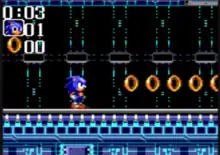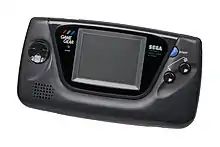Sonic Chaos
Sonic the Hedgehog Chaos[lower-alpha 1] is a 1993 side-scrolling platform video game published by Sega for the Master System and Game Gear. Players control Sonic the Hedgehog and his sidekick Miles "Tails" Prower in their quest to retrieve the Chaos Emeralds from Dr. Robotnik, who has stolen them to construct nuclear weapons. Gameplay involves running through stages, collecting rings, and defeating enemies. It is largely based on the Master System version of Sonic the Hedgehog 2, and is thus considered a follow-up to that game. Chaos also marks the debut of Tails as a playable character on the Game Gear.
| Sonic the Hedgehog Chaos | |
|---|---|
 Master System cover art | |
| Developer(s) | Aspect |
| Publisher(s) | Sega |
| Designer(s) | M. Shima |
| Composer(s) | Kojiro Mikusa |
| Series | Sonic the Hedgehog |
| Platform(s) | Master System, Game Gear |
| Release | Master System
|
| Genre(s) | Platform game |
| Mode(s) | Single-player |
Developed by Japanese studio Aspect Co., Chaos is the first original Sonic game made for a handheld, instead of a port or remake of an already-existing game. Based on their prior experience on producing Sonic games, Aspect had a far better grasp on how to design Chaos, and were able to build on its predecessors mechanics and make the gameplay generally faster. Chaos received a generally positive reception initially, with its levels and gameplay being praised, however in recent years it has gained a more average response for its unimpressive presentation and levels being of lackluster quality, alongside its slow framerate. A direct sequel, Sonic the Hedgehog: Triple Trouble, was released in 1994.
Gameplay

In Sonic Chaos, players control one of two characters — Sonic the Hedgehog or his sidekick Miles "Tails" Prower — and must complete each of the game's eight worlds in a quest to retrieve the Chaos Emeralds from the evil scientist Dr. Robotnik, who plots to use them to rule the world.[1] Each world, referred to as "zones" ingame, consists of two stages and a boss fight with Robotnik. Levels are designed to allow the player to move as quickly as possible, and are largely based on those in its precursor Sonic the Hedgehog 2. Gameplay itself involves running through each level while collecting rings and defeating Robotnik's robotic minions; rings protect Sonic and Tails from being hit by an enemy or obstacle. Levels also contain small television monitors that can be smashed to reveal a power-up icon, which grant Sonic and Tails with unique abilities, such as speed shoes, a one-hit shield, and extra lives.
Chaos adds several new editions to the core Sonic gameplay. Both characters have their own unique characteristics; Sonic can perform a move called the "Super Peel-Out", originally in Sonic CD, that makes him move extra fast, while Tails is able to fly and can hover over traps and other obstacles. Sonic can collect a new power-up called the "Rocket Shoes", which grant him the ability to fly for a short period of time; Tails is unable to use this, and will simply be granted extra rings if he were to smash a monitor containing Rocket Shoes. If Sonic collects 100 rings in a level, he will be teleported to a "Special Stage", where completing it will award him with a Chaos Emerald, an item needed to unlock the best ending.
Development and release

Sonic Chaos was developed by Japanese studio Aspect Co., being the third Sonic the Hedgehog game they produced, and published by Sega for the Master System and Game Gear.[2] Chaos is largely based on the Master System version of Sonic the Hedgehog 2, and is thus considered a follow-up or successor to that game.[3] With Aspect's prior experience on producing Sonic games, they had a better idea on how to design Chaos, and thus were able to greatly expand upon its predecessors in both design and visuals.[4][5] For the same reason, they were also able to make the game run faster.[4][5] Chaos is both the first original Sonic game for a handheld system, and the first to feature Tails as a unique playable character.[3]
Sonic Chaos was released for the Master System on October 25, 1993, and for the Game Gear on November 19 to coincide with the release of Sonic CD.[4][6] In Japan, it was titled Sonic & Tails.[6] Chaos is included as an extra in the GameCube version of Sonic Adventure DX: Director's Cut (2003) as one of the eleven unlockable Sonic Game Gear games, and in Sonic Mega Collection Plus (2005) for the PlayStation 2, Xbox, and PC.[7] In 2009, it was digitally-released for the Wii Virtual Console in North America.[8] Sonic Chaos is also included in the blue-colored model of the Game Gear Micro in 2020, alongside Gunstar Heroes, Sylvan Tale and Baku Baku Animal.[9]
Reception and legacy
| Publication | Score | |
|---|---|---|
| Master System | SGG | |
| EGM | N/A | 8.25/10[10] |
| Nintendo Life | N/A | |
| Entertainment Weekly | N/A | A-[12] |
Sonic Chaos initially received a positive response from publications. The four reviewers of Electronic Gaming Monthly commented that the Game Gear version retains all the elements that made the 16-bit Sonic games fun to play. They also praised the graphics and the ability to play as Tails.[10] Sonic Chaos was awarded Best Game Gear Game of 1993 by Electronic Gaming Monthly.[13] Entertainment Weekly gave the game an A- and wrote that the game may be enjoyable for younger children.[12] In their review for Sonic Mega Collection Plus, GameSpy felt that both it and the 8-bit Sonic the Hedgehog were the only Game Gear games in the series that are worth playing.[14]
In later years, Chaos was met with a more average reception. Nintendo Life criticized the Master System version for being a generally uninspired game, criticizing its difficulty for being too easy and its level designs for being bland and mediocre.[11] Retrospectively in 2019, Hardcore Gaming 101 gave a rather mixed response to the game; they felt disappointed with the gameplay and stage designs for lacking the uniqueness and puzzle-solving in Sonic the Hedgehog 2, and disliked its slow framerate.[15] They were also critical of the soundtrack for being generally lacking in quality and for the overall presentation being unimpressive.[15] Hardcore Gaming 101 said that Chaos was only worth checking out for dedicated Sonic fans writing: "Sonic Chaos is by no means a bad game, but it’s not a particularly great game either. It’s a functional platformer that’s only worth checking out if you’re really into 8-bit Sonic games, or have an interest in a traditional Sonic platformer with a bigger focus on exploration."[15]
A fan-made remake of Sonic Chaos was announced in 2018, and a demo was released in August 2018. It features 16-bit era-styled graphics, as well as new game mechanics and boss fights. VG247 described the project as "incredibly well produced" and wrote it could "pass for the next project from Sega after Sonic Mania."[16]
References
- Sonic the Hedgehog Chaos PAL Instruction Manual. Sega. 1993. pp. 8–10.
- Parish, Jeremy (June 5, 2014). "Who Makes the Best Sonic the Hedgehog Games?". USgamer. Gamer Network. Archived from the original on March 1, 2020. Retrieved March 6, 2018.
- Thorpe, Nick (22 March 2014). "The History of Sonic on the Master System". Retro Gamer (179).
- Ronaghan, Neal (June 21, 2013). "Grinding Game Gears: An Overview of Sonic's Portable Origins". Nintendo World Report. Archived from the original on 9 May 2019. Retrieved March 7, 2018.
- "Sonic Chaos". Electronic Gaming Monthly. No. 52. November 1993. p. 148.
- "[セガハード大百科] ゲームギア対応ソフトウェア(ライセンシー発売)" (in Japanese). Sega. Archived from the original on November 6, 2019. Retrieved August 13, 2020.
- Bramwell, Tom (11 May 2005). "Sonic Mega Collection Plus". Eurogamer. Gaming Network. Archived from the original on 16 October 2019. Retrieved 1 March 2020.
- Chester, Nick (2 February 2009). "Wii Shop Update: Snowboard Riot, LONPOS, and Sonic Chaos". Destructoid. Archived from the original on 26 September 2009. Retrieved 1 March 2020.
- Byford, Sam (October 16, 2020). "Game Gear Micro Review: Peak Sega". The Verge. Retrieved November 4, 2020.
- "Review Crew: Sonic Chaos". Electronic Gaming Monthly. No. 54. Sendai Publishing. January 1994. p. 52.
- Nintendo Life Staff (3 February 2009). "Sonic Chaos Review (SMS)". NintendoLife. Archived from the original on 3 May 2019. Retrieved 29 February 2020.
- Strauss, Bob (February 11, 1994). "Sonic CD; Sonic Chaos; Sonic Spinball; Sonic 3 reviews". Entertainment Weekly. No. 209. Meredith Corporation. Archived from the original on 2018-09-05. Retrieved 2020-02-29.
- "Electronic Gaming Monthly's Buyer's Guide". 1994. Cite journal requires
|journal=(help) - Baker, Chris (November 1, 2004). "GameSpy: Sonic Mega Collection Plus". GameSpy. p. 2. Archived from the original on March 3, 2016. Retrieved July 24, 2018.
- Chungus, Apollo (18 July 2019). "Sonic Chaos". Hardcore Gaming 101. Archived from the original on 25 November 2019. Retrieved 29 February 2020.
- Donaldson, Alex (August 28, 2018). "The Sonic community just released a slew of amazing fangame demos". VG247. Archived from the original on August 28, 2018. Retrieved August 29, 2018.